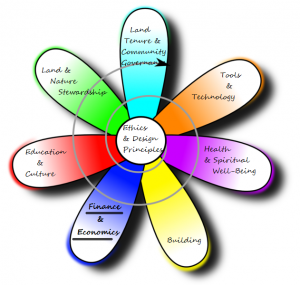Permaculture Design And Stock Market Investing

Active vs. Passive investing. Image by Zynatis/shutterstock.
Today’s stock market is a dynamic and scary place.
Once upon a time choosing stocks to invest in based on the fundamental value of the companies they represent (called fundamental or value investing) was the dominant paradigm for investors. No longer.
In 2017, JP Morgan estimated that only 10 percent of trading came from fundamental investors. The vast majority of trading now comes from computer based algorithmic trading, and passive investors following pre-defined rules, such as index investors. According to Morningstar, nearly 45 percent of all stocks are owned by passive investors. These should be combined with “near passive” strategies, like over a third of “active” mutual funds which track their benchmarks so closely that no matter how skilled, they will not be able to beat the benchmark by enough to justify their fees.
The very prevalence of passive investors owes its rise to the belief that a fundamental investor’s task is ultimately futile.The popularity of passive investing grows along with the belief that the rewards of active investing do not justify the costs of the diligent investment research required to do it well.
This is a self-undermining prophecy. Active investing preserves the health of the stock market, ensuring that stocks trade near their fundamental values because fundamental investors sell stocks that become overvalued (lowering the price) and buy stocks which become undervalued (raising the price). In the absence of fundamental investors, stock prices cease to reflect their fundamental values, which in turn increases the rewards to skilled fundamental investors.
As most investors abandon any attempt to beat the market, the potential rewards the courageous few who remain can only grow. But potential profits will not become actual gains without investing skill.

A farmer in a modern tractor mowing an endless field. Image by RikoBest/Shutterstock.
I see strong parallels between the recent move towards passive investing and the transition of small scale farming to modern agriculture. Modern, mechanized farming is a success in its ability to produce tremendous amounts of food with very little labor, benefiting consumers with incredibly low priced food.
Unfortunately, the benefits of mechanized farming come with many hidden costs, most of which are not immediately felt by either the farmers or consumers. Monocultures leave farms more vulnerable to pests, and reduce biodiversity which supports native pollinators. Eschewing natural pest control requires the increased use of pesticides which often contaminate the environment and even the food produced, while killing beneficial organisms in the soil. Degraded soil requires increased fertilizer use, which further degrades the soil and contaminates the environment.
Passive investing also leads to harmful effects on the stock market as a whole. Fundamental investors have a stabilizing effect on the market as a whole, because they buy stocks when the prices fall below their estimates of fundamental value, and sell stocks when prices rise compared to those estimates.
Passive index investing, in contrast, can exacerbate stock volatility. Index investors own the companies in stock market indexes such as the S&P 500. The S&P 500 is composed of the 500 companies with the largest market capitalization. Since market capitalization is the product of the stock price and the number of shares outstanding, companies are added to the S&P 500 and similar indexes as their stock price rises and increases their market capitalization to a level sufficient for inclusion in the index. Similarly, stocks are dropped from the index when the price and market capitalization fall below that level. When a stock is added to the index that an index investor tracks, the investor buys that stock. When it is removed, the index investor sells. So index additions and removals accelerate the rise or fall of stocks that are already rising or falling.
Where farming monocultures decrease biodiversity, passive investing reduces the effectiveness of stock market diversification. Stock market diversification is the idea that by owning small amounts of a large number of stocks, the investor is protected from events that effect only one or a few of those stocks. While passive investors are typically very diversified in the sense that they own a large number of different stocks, the large number of passive investors following the same few indexes has the effect of turning those indexes into effective monocultures. Passive investors do not make decisions to buy or sell individual stocks because of the value of those stocks. Instead, they decide to buy or sell the entire stock market index as a whole. When events such as investment bubbles or financial crises lead index investors to buy or sell as a group, they buy or sell the stocks in their indexes as a group, causing those stocks to rise or fall as a group.
While passive investors may draw comfort from the apparent diversification of owning a large number of stocks, the benefits of that apparent diversification often prove to be illusory when they are needed most. The vary prevalence of passive investing opens passive investors up to new risks in a way that is very similar the dependence of commercial agriculture on a very few crop species leaves farmers open to increased risks of pests and disease.
Finally, the rise of factory farming has led to a decline in farmers eating the food they grow. This leads to a tendency to prioritize volume of production and potential over the health benefits of the food they grow. A farmer growing commodity corn that will be sent to a processing plant mixed with grain from hundreds of other farmers is going to be a lot less concerned about the quality of the corn than a farm family that eats part of everything they grow.
In the stock market, most passive investors are not even sure which companies they own, and so they play no role in overseeing company management. Fundamentally motivated investors, in contrast, make individual decisions about the stocks they buy and sell. When that buying or selling comes in response to management actions that increase or decrease the value of the company, the net effect of their response on the share price is valuable feedback for management that their actions have consequences.
Where active investors invest through socially conscious funds or directly in individual stocks, they may also reward companies that they judge are aligned with their morals. There is a widespread and, in my opinion, false belief that the sole goal of stock market investing should be to make money. I believe that this belief could only have developed in an investment culture like our own when individuals cede direct control of their investments to professional money managers. In this environment, it is in the money manager’s interest to believe that the only thing he needs to worry about is making money, because this makes his job easier. In the case of the client, this belief is useful in that it reduces the complexity of choosing a money manager.
While some active investors consciously choose to invest in companies that are aligned with their morals, no active investor makes decisions in a moral vacuum. As part of the valuation process, investors become familiar with a company’s business. If they like what the company does, they will tend to be more optimistic about its prospects, increasing their subjective valuation. If they find the business morally repugnant, some will simply choose to analyze something more pleasant. Others will be less optimistic about its prospects and give it a lower valuation. Even the most numerically focused analysis will, of necessity, include estimates about the future, and these estimates are inevitably subjective and influenced by the analyst’s emotions (and moral judgement) about the company.
Far from being a problem, active investors’ and analysts’ preferences for companies aligned with their morals is a good thing. When such active investors influence the market, they will tend to provide companies that align with their morals more capital, and those businesses will be able to grow faster than businesses many investors find repugnant. In this way, a stock market dominated by active investors who directly control their own investments leads to more companies that behave in a fashion aligned with their investors morals. A stock market dominated by passive investors and money managers who belie that making money is the beginning and end of their obligation to their clients will be dominated by amoral companies.
A Permaculture Portfolio

The Permaculture movement was founded to bring the humanity back into farming, in reaction to modern mechanized agriculture as the latter ceased to serve any human needs beyond simple sustenance, and as it became apparent that the consequences of that type of agriculture were having long term, adverse effects beyond the agricultural system. The permaculture ethics and design principles were designed with this problem in mind.
As I’ve argued above, modern finance and the modern economy has largely ceased to serve human needs beyond the need for more money. The adverse consequences of our current amoral investing culture are also long term and widespread through the entire economy. I began to see the parallel when I agreed to do a talk on investing to my local Permaculture Meetup group. I decided to apply the design principles to investing, and was surprised at how many of the principles I already use in an investing strategy that I have developed over the last two decades. The parallels feel almost uncanny. My only explanation is that similar problems in the seemingly different realms of agriculture and finance lend themselves to similar solutions.
I now feel that, if I had started off twenty years ago intentionally trying to apply the permaculture principles to investing, I would have arrived at my strategy much earlier.
You can see how the permaculture ethics of earth care, people care, and fair share and the twelve principles apply to investing in the presentation I gave at that talk. I plan to write a few follow-ups on how particular permaculture ethics and design principles apply to investing, but I doubt I will have time to write about all of them. If there is a particular principle or group of principles that particularly interests you in how it relates to investing, leave a comment and help me decide what the next article will be.
Disclaimer: Past performance is not a guarantee or a reliable indicator of future results. This article contains the current opinions of the author and such opinions ...
more


